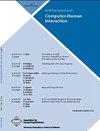数据物理化的设计词汇
IF 4.8
2区 计算机科学
Q1 COMPUTER SCIENCE, CYBERNETICS
引用次数: 0
摘要
尽管代表数据的物理人工制品已经使用了几个世纪,但这一研究领域——被称为数据物理化——直到最近才获得关注。与数据可视化相比,没有现成的词汇来分析和讨论物理化的特性。通过对实例和文献的深入分析,我们提出了一个全面的设计词汇表,它由三个独立但相连的部分组成:“显式变量”、“隐式属性”和“相应方面”。显式变量建立在可视化中已知的视觉变量之上,并对其进行扩展,以解释物理化的多模态性质。隐式属性涉及物理化的设计意图和用户体验的核心元素,但不是“显式”编码策略的结果。最后,间接方面指的是设计决策的无意影响,它影响了物理化的体验。我们的工作说明了物理化是如何结合其他数据表示中所没有的机会和挑战的,例如体现和“想象中的触摸”。有了这一点,我们有助于生成关于物理化的理论。我们的设计词汇可以支持(1)创作者通过告知他们的设计过程和强调设计策略,(2)教育工作者,以及(3)学者和从业者分析现有的物理化,并反思设计决策对解释和体验的影响。本文章由计算机程序翻译,如有差异,请以英文原文为准。
A Design Vocabulary for Data Physicalization
Although physical artifacts that represent data have been used for centuries, the research field –known as data physicalization– has only recently gained traction. Compared to data visualization, there is no established vocabulary for analysing and discussing the properties of physicalizations. Through a grounded analysis of examples and literature, we propose a comprehensive design vocabulary, which consist of three separate, but connected parts: ‘explicit variables’, ‘implicit properties’, and ‘consequential aspects’. Explicit variables build on visual variables known from visualization and extend it to account for physicalization’s multi-modal nature. Implicit properties concern elements which are central to the design intention and user experience of physicalizations, yet are not a result of ‘explicit’ encoding strategies. Finally, consequential aspects refer to unintentional effects of design decisions, that influence how a physicalization is experienced. Our work illustrates how physicalizations incorporate opportunities and challenges that are not afforded in other data representations, such as embodiment and ‘imagined touch’. With this, we contribute to generating theory on physicalization. Our design vocabulary can support (1) creators through informing their design processes and highlighting design strategies, (2) educators, and (3) academics and practitioners to analyse existing physicalizations, and reflect on the impact of design decisions on interpretation and experience.
求助全文
通过发布文献求助,成功后即可免费获取论文全文。
去求助
来源期刊

ACM Transactions on Computer-Human Interaction
工程技术-计算机:控制论
CiteScore
8.50
自引率
5.40%
发文量
94
审稿时长
>12 weeks
期刊介绍:
This ACM Transaction seeks to be the premier archival journal in the multidisciplinary field of human-computer interaction. Since its first issue in March 1994, it has presented work of the highest scientific quality that contributes to the practice in the present and future. The primary emphasis is on results of broad application, but the journal considers original work focused on specific domains, on special requirements, on ethical issues -- the full range of design, development, and use of interactive systems.
 求助内容:
求助内容: 应助结果提醒方式:
应助结果提醒方式:


